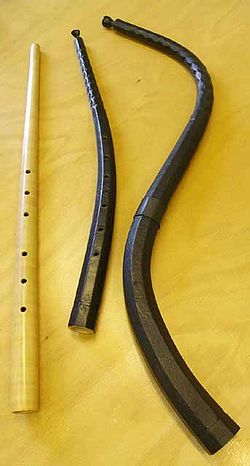
Back Цинк (музикален инструмент) Bulgarian Cornetto Catalan Cink Czech Zink (musikinstrument) Danish Zink (Musik) German Senpiŝtokorneto Esperanto Cornetto Spanish Tsink (muusikainstrument) Estonian Cornetto Basque Sinkki (soitin) Finnish
 Three different cornetts: mute cornett, curved cornett and tenor cornett. | |
| Brass instrument | |
|---|---|
| Classification | Brass instrument Horn |
| Hornbostel–Sachs classification | 423.212 (Keyed trumpets, Irregular bore). An aerophone, the vibrating air is enclosed within the instrument, the player's lips cause the air to vibrate directly, the pitch of the instrument can be altered mechanically, keyed trumpets, with an Irregular bore) |
| Developed | Related to all wind instruments made of animal horn and sounded by the vibration of pressed lips. Animal horn with fingerholes such as the coradoiz was "precursor."[1] |
| Playing range | |
|
| |
| Related instruments | |
| rozhok, serpent | |
The cornett, cornetto, or zink is a wind instrument that dates from the Medieval, Renaissance and Baroque periods, popular from 1500 to 1650.[2]
It was used in a variety of situations, including performances by professional musicians, state music and liturgical music. It accompanied choral music. It also featured in popular music in what are now called alta capellas or loud wind ensembles.[3] Anthony Baines notes that the cornett "[...] was praised in the very terms that were to be bestowed upon the oboe [...]: it could be sounded as loud as a trumpet and as soft as a recorder, and its tone approached that of the human voice more nearly than that of any other instrument."[4] It was popular in Germany, where guild laws made it illegal for residents to play trumpets.[5] As well, the mute cornett variant was a quiet instrument, playing "gentle, soft and sweet."[6]
The instrument has features of both the trumpet and the flute. Like the trumpet, the cornett has a mouthpiece or cup, where the instrument is sounded with the player's lips.[7] Like the flute, it has fingerholes (and sometimes keys) to determine pitch; pitch can also be changed on low notes by the tension of the player's lips.[7] Instrument-makers built cornetts in two styles, straight and curved. They also produced a variety of sizes from highest cornettino downward through alto cornett, cornone tenor cornett, and bass cornett.[5] The cornett is not to be confused with the modern cornet.[5] The spelling cornet which had applied to the instrument in this article since about 1400 A.D. was transferred to a brass-tubed trumpet (formerly known as a cornet à pistons[8]) from about 1836,[9] and cornett became the modern spelling of the older instrument.[10] The most common form is the curved cornett, also called treble cornett or alto cornett.[11]
- ^ Marcuse, Sibyl (1964). "Coradoiz". Musical Instruments, A Comprehensive Dictionary. Garden City, New York: Doubleday and Company. p. 124.
- ^ "Zink". Dictionary.com. Retrieved 2012-05-26.
- ^ Howard Mayer Brown; Keith Polk (2001). "Alta (i)". In Deane Root (ed.). Grove Music Online. doi:10.1093/gmo/9781561592630.article.00676. Retrieved 26 January 2023.
alta musique (Fr.) or 'loud music' as opposed to basse musique, 'soft music'
- ^ Baines, Anthony (1957). Woodwind Instruments and Their History. New York: W. W. Norton & Company, Inc. pp. 259–60. ISBN 9780486268859.
- ^ a b c Marcuse, Sibyl (1964). "Cornett". Musical Instruments, A Comprehensive Dictionary. Garden City, New York: Doubleday and Company. p. xi, 128.
- ^ Marcuse, Sibyl (1964). "Mute cornett". Musical Instruments, A Comprehensive Dictionary. Garden City, New York: Doubleday and Company. p. 354.
- ^ a b Anthony C. Baines; Bruce Dickey (2001). "Cornett (Fr. cornet-à-bouquin; Ger. Zink; It. cornetto; Sp. corneta". Grove Music Online. Oxford University Press. doi:10.1093/gmo/9781561592630.article.06516.
- ^ "cornet à piston". Oxford English Dictionary (Online ed.). Oxford University Press. (Subscription or participating institution membership required.)
- ^ "cornet". Oxford English Dictionary (Online ed.). Oxford University Press. (Subscription or participating institution membership required.)
- ^
Marcuse, Sibyl (1964). "Cornett". Musical Instruments, A Comprehensive Dictionary. Garden City, New York: Doubleday and Company. p. 128.
Its correct Engl. name, 'cornet' [...] having been bestowed on a modern brass instrument, the word is nowadays customarily written 'cornett.'
- ^ Knock, 2020, page 33
© MMXXIII Rich X Search. We shall prevail. All rights reserved. Rich X Search
